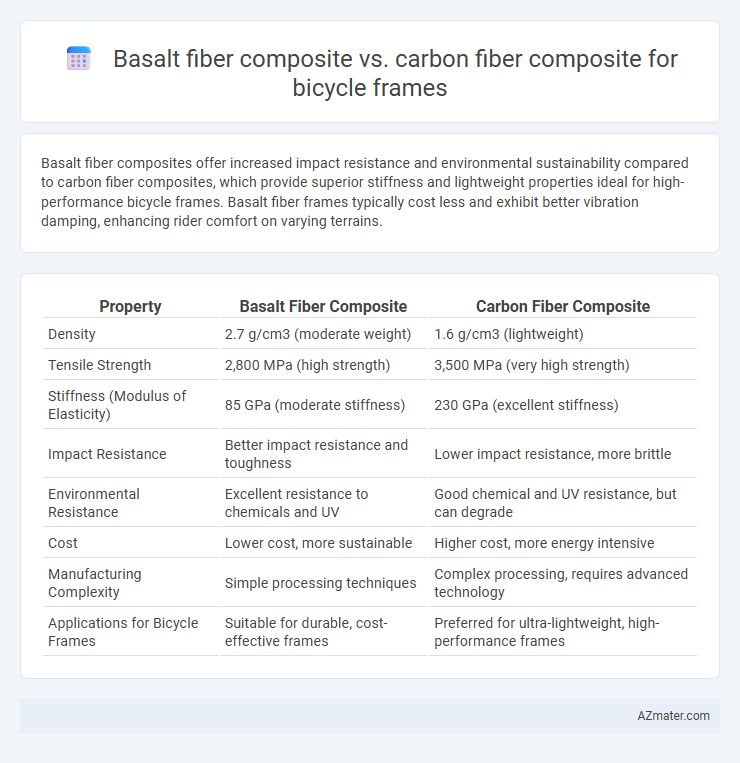Basalt fiber composites offer increased impact resistance and environmental sustainability compared to carbon fiber composites, which provide superior stiffness and lightweight properties ideal for high-performance bicycle frames. Basalt fiber frames typically cost less and exhibit better vibration damping, enhancing rider comfort on varying terrains.
Table of Comparison
| Property | Basalt Fiber Composite | Carbon Fiber Composite |
|---|---|---|
| Density | 2.7 g/cm3 (moderate weight) | 1.6 g/cm3 (lightweight) |
| Tensile Strength | 2,800 MPa (high strength) | 3,500 MPa (very high strength) |
| Stiffness (Modulus of Elasticity) | 85 GPa (moderate stiffness) | 230 GPa (excellent stiffness) |
| Impact Resistance | Better impact resistance and toughness | Lower impact resistance, more brittle |
| Environmental Resistance | Excellent resistance to chemicals and UV | Good chemical and UV resistance, but can degrade |
| Cost | Lower cost, more sustainable | Higher cost, more energy intensive |
| Manufacturing Complexity | Simple processing techniques | Complex processing, requires advanced technology |
| Applications for Bicycle Frames | Suitable for durable, cost-effective frames | Preferred for ultra-lightweight, high-performance frames |
Introduction to Composite Bicycle Frames
Composite bicycle frames integrate advanced materials to enhance strength-to-weight ratios and performance. Basalt fiber composites offer excellent vibration damping, corrosion resistance, and impact toughness compared to traditional carbon fiber composites known for superior stiffness and lightweight properties. Selection depends on ride quality preferences, durability requirements, and cost considerations within high-performance and endurance cycling segments.
What is Basalt Fiber Composite?
Basalt fiber composite, derived from volcanic basalt rock, offers high strength, excellent thermal stability, and remarkable vibration damping properties, making it a viable alternative to carbon fiber composites for bicycle frames. Its natural origin contributes to better environmental sustainability, while maintaining comparable mechanical performance and improved impact resistance. This composite type provides a unique balance of durability, lightweight construction, and cost-effectiveness for high-performance cycling applications.
What is Carbon Fiber Composite?
Carbon fiber composite is a high-strength, lightweight material made by embedding carbon fibers into a polymer matrix, often epoxy resin, which provides exceptional stiffness and durability for bicycle frames. Its superior tensile strength and excellent fatigue resistance make it ideal for high-performance cycling applications where weight reduction and rigidity are crucial. Carbon fiber composites also offer better vibration damping compared to metals, enhancing rider comfort during long rides.
Material Properties Comparison
Basalt fiber composites offer higher impact resistance and better vibration damping compared to carbon fiber composites, making them suitable for absorbing shocks in bicycle frames. Carbon fiber composites provide superior stiffness-to-weight ratio and tensile strength, resulting in lighter and more rigid frames ideal for competitive cycling. Both materials exhibit excellent corrosion resistance and fatigue life, but basalt fiber composites tend to be more cost-effective and environmentally friendly.
Weight and Strength Analysis
Basalt fiber composites offer a notable balance between weight and strength, typically weighing slightly more than carbon fiber composites while providing comparable tensile strength and improved impact resistance. Carbon fiber composites are favored for their superior strength-to-weight ratio, often resulting in lighter bicycle frames with higher stiffness, enhancing performance and responsiveness. While carbon fiber excels in stiffness and weight reduction, basalt fiber composites present a cost-effective alternative with better vibration damping and toughness, suitable for riders prioritizing durability.
Ride Quality and Vibration Damping
Basalt fiber composite offers superior vibration damping compared to carbon fiber composite, enhancing ride comfort by absorbing road irregularities more effectively. Carbon fiber composites provide higher stiffness and strength-to-weight ratios, resulting in more precise handling but transmit more vibrations to the rider. For bicycle frames prioritizing ride quality and reduced fatigue, basalt fiber composites present a compelling option without sacrificing durability.
Durability and Environmental Resistance
Basalt fiber composite offers superior durability with excellent impact resistance and vibration damping, making it an effective alternative to carbon fiber composites in bicycle frames. Its natural basalt origin provides enhanced environmental resistance against moisture, UV radiation, and chemicals, extending frame lifespan under various weather conditions. While carbon fiber composites deliver higher stiffness and lightweight properties, basalt fiber composites excel in toughness and eco-friendly performance for sustainable cycling applications.
Manufacturing Process Differences
Basalt fiber composites involve melting volcanic rocks and extruding continuous fibers, followed by weaving and resin impregnation, which demands lower processing temperatures compared to carbon fiber composites that require high-temperature carbonization of polyacrylonitrile (PAN) fibers. The manufacturing of basalt composites benefits from simpler, less energy-intensive processes with enhanced environmental sustainability, while carbon fiber composites need precise control during oxidation and carbonization stages to achieve superior mechanical properties. These differences influence frame production cost, cycle time, and scalability, making basalt fiber composites attractive for cost-effective and eco-friendly bicycle frame manufacturing.
Cost Comparison and Market Availability
Basalt fiber composites typically cost 20-40% less than carbon fiber composites, making them a more budget-friendly option for bicycle frames while still offering high strength and durability. Carbon fiber composites dominate the market due to their superior stiffness-to-weight ratio and extensive availability from numerous manufacturers and suppliers worldwide. Basalt fiber's market presence is growing but remains limited compared to the widespread commercial use and established supply chains of carbon fiber.
Which Composite is Best for Bicycle Frames?
Basalt fiber composites offer superior vibration damping and impact resistance compared to carbon fiber composites, making them ideal for comfort-focused bicycle frames. Carbon fiber composites excel in stiffness-to-weight ratio and tensile strength, providing unparalleled performance for competitive cycling and lightweight designs. Choosing the best composite depends on the rider's priorities: durability and shock absorption favor basalt fiber, while maximum strength and minimal weight favor carbon fiber.

Infographic: Basalt fiber composite vs Carbon fiber composite for Bicycle frame
 azmater.com
azmater.com